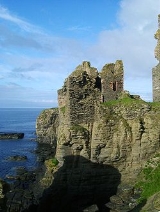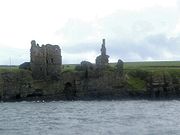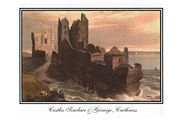
Sinclair & Girnigoe Castle
Encyclopedia
Castle Sinclair Girnigoe is a castle
located about 3 miles north of Wick
on the east coast of Caithness
, Scotland
, United Kingdom
. It is considered to be one of the earliest seats of Clan Sinclair
.

 In its earliest incarnation, Castle Sinclair Girnigoe was known only as Castle Girnigoe. It was built by William Sinclair
In its earliest incarnation, Castle Sinclair Girnigoe was known only as Castle Girnigoe. It was built by William Sinclair
, the 2nd Earl of Caithness
, probably sometime between 1476 and 1496, but before his death at the Battle of Flodden in 1513.
There are some indications that the castle was built upon the foundations of an earlier fortalice. source
In 1577, George Sinclair, the 4th Earl of Caithness imprisoned his own son John, Master of Caithness in Castle Sinclair Girnigoe, on suspicion of rebelling against his rule. He was held there for seven years, after which his father fed him a diet of salted beef, with nothing to drink, so that he eventually died insane from thirst. source
The castle was extended in 1606, with new structures consisting of a gatehouse
and other buildings surrounded by a curtain wall
, these connected to rest of the castle by a drawbridge
over a rock-cut ravine. At this time, the Earl of Caithness obtained official permission, in an Act of Parliament, to change the name from Castle Girnigoe to Castle Sinclair. However, both names remained in use.
Girnigoe was an adapted 5 story L-plan
crow-stepped gabled
tower house
, which sat upon a rocky promontory jutting out into Sinclair Bay. This tower was adjoined to various outbuildings within a surrounding wall which encompassed the entire promontory. There is some evidence to suggest that the tower house of Girnigoe is a 17th century addition. Girnigoe has a number of special architectural details, including a small secret chamber in the vaulted ceiling of the kitchen, a rock-cut stairway down to the sea, and a well (now filled-in) in the lowest level of the tower.
Castle Sinclair Girnigoe was continuously inhabited by the Sinclair Earls of Caithness until George Sinclair, the 6th Earl of Caithness died without issue in 1676, after which John Campbell of Glen Orchy, who married George Sinclair’s widow, claimed the title of Earl of Caithness, as well as Castle Sinclair Girnigoe. George Sinclair of Keiss
, who was considered the rightful heir, stormed the castle in 1679, an action which led to the Battle of Altimarlech in 1680, in which the Campbells were victorious.
In 1690, George Sinclair of Keiss once again besieged the castle, but this time destroyed it with heavy cannon fire, though recent investigations seem to discount the cannon fire story. Although he reclaimed the title of Earl of Caithness for Clan Sinclair, Castle Sinclair Girnigoe was now a ruined shell. Until recently, it had been allowed to fall into decay.
has begun restoration work on the Castle, in an attempt to preserve the archeological and historical importance of the structure. Once restored, it will be one of the few castles open to the public which are accessible to handicapped people.
Castle
A castle is a type of fortified structure built in Europe and the Middle East during the Middle Ages by European nobility. Scholars debate the scope of the word castle, but usually consider it to be the private fortified residence of a lord or noble...
located about 3 miles north of Wick
Wick, Highland
Wick is an estuary town and a royal burgh in the north of the Highland council area of Scotland. Historically, it is one of two burghs within the county of Caithness, of which Wick was the county town. The town straddles the River Wick and extends along both sides of Wick Bay...
on the east coast of Caithness
Caithness
Caithness is a registration county, lieutenancy area and historic local government area of Scotland. The name was used also for the earldom of Caithness and the Caithness constituency of the Parliament of the United Kingdom . Boundaries are not identical in all contexts, but the Caithness area is...
, Scotland
Scotland
Scotland is a country that is part of the United Kingdom. Occupying the northern third of the island of Great Britain, it shares a border with England to the south and is bounded by the North Sea to the east, the Atlantic Ocean to the north and west, and the North Channel and Irish Sea to the...
, United Kingdom
United Kingdom
The United Kingdom of Great Britain and Northern IrelandIn the United Kingdom and Dependencies, other languages have been officially recognised as legitimate autochthonous languages under the European Charter for Regional or Minority Languages...
. It is considered to be one of the earliest seats of Clan Sinclair
Clan Sinclair
Clan Sinclair is a Highland Scottish clan of Norman origin who held lands in the north of Scotland, the Orkney Islands, and the Lothians which they received from the Kings of Scots...
.
History


William Sinclair, 2nd Earl of Caithness
William Sinclair, 2nd Earl of Caithness was a Scottish nobleman born in Ravenscraig Castle, Kirkcaldy, Scotland to William Sinclair, 1st Earl of Caithness and Marjory Sutherland. He married Margaret Keith, daughter of Sir Gilbert Keith...
, the 2nd Earl of Caithness
Earl of Caithness
Earl of Caithness is a title that has been created several times in the Peerage of Scotland, and has a very complex history. Its first grant, in the modern sense as to have been counted in strict lists of peerages, is now generally held to have taken place in favor of Maol Íosa V, Earl of...
, probably sometime between 1476 and 1496, but before his death at the Battle of Flodden in 1513.
There are some indications that the castle was built upon the foundations of an earlier fortalice. source
In 1577, George Sinclair, the 4th Earl of Caithness imprisoned his own son John, Master of Caithness in Castle Sinclair Girnigoe, on suspicion of rebelling against his rule. He was held there for seven years, after which his father fed him a diet of salted beef, with nothing to drink, so that he eventually died insane from thirst. source
The castle was extended in 1606, with new structures consisting of a gatehouse
Gatehouse
A gatehouse, in architectural terminology, is a building enclosing or accompanying a gateway for a castle, manor house, fort, town or similar buildings of importance.-History:...
and other buildings surrounded by a curtain wall
Curtain wall (fortification)
A curtain wall is a defensive wall between two bastions of a castle or fortress.In earlier designs of castle the curtain walls were often built to a considerable height and were fronted by a ditch or moat to make assault difficult....
, these connected to rest of the castle by a drawbridge
Drawbridge
A drawbridge is a type of movable bridge typically associated with the entrance of a castle surrounded by a moat. The term is often used to describe all different types of movable bridges, like bascule bridges and lift bridges.-Castle drawbridges:...
over a rock-cut ravine. At this time, the Earl of Caithness obtained official permission, in an Act of Parliament, to change the name from Castle Girnigoe to Castle Sinclair. However, both names remained in use.
Girnigoe was an adapted 5 story L-plan
L Plan Castle
An L-plan castle is a castle or towerhouse in the shape of an L, typically built in the 13th to the 17th century. This design is found quite frequently in Scotland, but is also seen in England, Ireland, Romania, Sardinia, and other locations. The evolution of its design was an expansion of the...
crow-stepped gabled
Gables
Gables may refer to:* Gables, portion of walls between the lines of sloping roofs* Ken Gables , Major League Baseball pitcher* Gables, Nebraska, an unincorporated community in the United States...
tower house
Tower house
A tower house is a particular type of stone structure, built for defensive purposes as well as habitation.-History:Tower houses began to appear in the Middle Ages, especially in mountain or limited access areas, in order to command and defend strategic points with reduced forces...
, which sat upon a rocky promontory jutting out into Sinclair Bay. This tower was adjoined to various outbuildings within a surrounding wall which encompassed the entire promontory. There is some evidence to suggest that the tower house of Girnigoe is a 17th century addition. Girnigoe has a number of special architectural details, including a small secret chamber in the vaulted ceiling of the kitchen, a rock-cut stairway down to the sea, and a well (now filled-in) in the lowest level of the tower.
Castle Sinclair Girnigoe was continuously inhabited by the Sinclair Earls of Caithness until George Sinclair, the 6th Earl of Caithness died without issue in 1676, after which John Campbell of Glen Orchy, who married George Sinclair’s widow, claimed the title of Earl of Caithness, as well as Castle Sinclair Girnigoe. George Sinclair of Keiss
Keiss
Keiss is a fishing village at the northern end of Sinclairs Bay on the east coast of Caithness in the Scottish council area of Highland.Keiss Castle, which is now partially ruined, is located less than 1 mile north of the village centre, on sheer cliffs, overlocking the bay, and has been a major...
, who was considered the rightful heir, stormed the castle in 1679, an action which led to the Battle of Altimarlech in 1680, in which the Campbells were victorious.
In 1690, George Sinclair of Keiss once again besieged the castle, but this time destroyed it with heavy cannon fire, though recent investigations seem to discount the cannon fire story. Although he reclaimed the title of Earl of Caithness for Clan Sinclair, Castle Sinclair Girnigoe was now a ruined shell. Until recently, it had been allowed to fall into decay.
The Castle today
Recently, the Clan Sinclair TrustClan Sinclair Trust
The Clan Sinclair Trust is a Scottish trust which was formed with the main objective of rescuing and preserving Castle Sinclair Girnigoe and of developing a visitor centre and library. The Chief Executive is Malcolm Sinclair, 20th Earl of Caithness and John Sinclair, 3rd Viscount Thurso and are...
has begun restoration work on the Castle, in an attempt to preserve the archeological and historical importance of the structure. Once restored, it will be one of the few castles open to the public which are accessible to handicapped people.
See also
- Battle of ChampionsBattle of ChampionsThe Battle of Champions was a trial by combat fought in 1478 or 1464 between two Scottish clans, Clan Gunn and Clan Keith. It took place at the chapel of St Tears on the coast north of Wick in Caithness, between Ackergill Tower and Girnigoe Castle. It was arranged to settle a dispute with a battle...
- fought just west of the castle in 1478 or 1464 - Castle of MeyCastle of MeyThe Castle of Mey is located in Caithness, on the north coast of Scotland, about west of John o' Groats. In fine weather there are views from the castle north to the Orkney Islands.-History:...
- Roslin CastleRoslin CastleRoslin Castle is a partially ruined castle near the village of Roslin in Midlothian, Scotland. It is located around 9 miles south of Edinburgh, on the north bank of the North Esk, only a few hundred metres from the famous Rosslyn Chapel.There has been a castle on the site since the early 14th...
- Rosslyn ChapelRosslyn ChapelRosslyn Chapel, properly named the Collegiate Chapel of St Matthew, was founded on a small hill above Roslin Glen as a Roman Catholic collegiate church in the mid-15th century...
- Sinclair (surname)Sinclair (surname)The Scoto-Norman surname Sinclair comes from the Clan Sinclair whose progenitors conquered England with William the Conqueror then moved to Scotland and were given the land of Roslin, Midlothian by the King of Scots....

